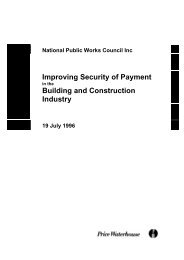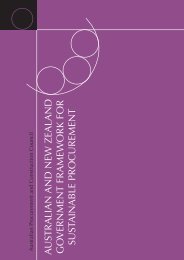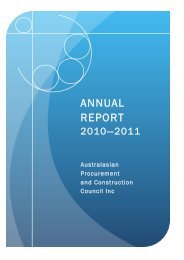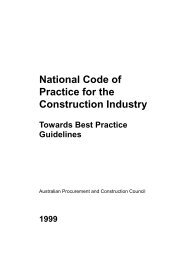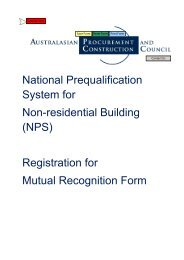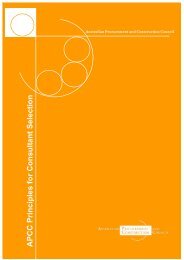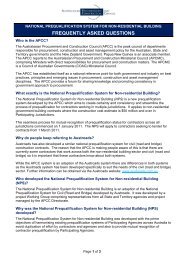ESD design guide for Australian Government buildings: Edition 2
ESD design guide for Australian Government buildings: Edition 2
ESD design guide for Australian Government buildings: Edition 2
You also want an ePaper? Increase the reach of your titles
YUMPU automatically turns print PDFs into web optimized ePapers that Google loves.
esd opportunities in building<br />
OPPORTUNITY 8<br />
minimising waste<br />
Figure 33: waste management in<br />
construction, DEH.<br />
IMPORTANCE OF MINIMISING<br />
WASTE<br />
Waste is a major environmental issue<br />
in the built environment with more<br />
than 40% of landfill resulting from<br />
building-related waste. One of the<br />
major imperatives of sustainable<br />
<strong>design</strong> is to use the waste hierarchy<br />
of avoid, reduce, reuse and recycle.<br />
That is, do not order it if you do not<br />
need it; plan use so as to optimise<br />
material efficiency (<strong>design</strong> height <strong>for</strong><br />
plasterboard size); put aside cut offs<br />
<strong>for</strong> later reuse; etc. (see figure 33).<br />
OPTIMISING WASTE<br />
MINIMISATION<br />
Waste minimisation involves a<br />
diligent approach to documentation<br />
and project management in order<br />
to minimise the amount of waste<br />
produced on site during demolition<br />
and construction. It also recognises<br />
the potential of some materials to<br />
be reused or recycled rather than<br />
allowing them to contribute to waste<br />
volumes going to landfill; the focus<br />
being a more efficient use of finite<br />
resources.<br />
The environmental opportunities<br />
of waste management include<br />
the reduction of demolition and<br />
construction waste streams, as well<br />
as those resulting from ongoing<br />
operational waste during the life-cycle<br />
of the building. The key when thinking<br />
about minimising waste is to go<br />
through each decision using the waste<br />
minimisation hierarchy noted above.<br />
Design Stage<br />
The <strong>design</strong> stage produces very<br />
little waste comparatively. Yet this is<br />
the stage where many of the waste<br />
opportunities can be optimised.<br />
Some strategies are outlined below:<br />
Design <strong>for</strong><br />
materials<br />
and <strong>design</strong><br />
<strong>for</strong> standard<br />
sizes<br />
Design <strong>for</strong><br />
flexibility<br />
Design of<br />
assembly<br />
and<br />
disassembly<br />
Design using<br />
prefabricated<br />
components<br />
Design <strong>for</strong><br />
ease of<br />
recycling<br />
Design ceiling dimensions<br />
to make best use of<br />
materials – <strong>for</strong> example<br />
if plasterboard comes in<br />
1200mm don’t <strong>design</strong><br />
ceiling heights to be<br />
2700mm, since 2400mm<br />
would make better use of<br />
the material and minimise<br />
waste.<br />
Design spaces and<br />
systems that can easily<br />
adapted to changes<br />
in management and<br />
company structures.<br />
More and more systems<br />
are being developed that<br />
allow <strong>buildings</strong> to be<br />
built in a way that allows<br />
them to be disassembled<br />
and reused. This is not<br />
mainstream in Australia<br />
yet but the trend in Europe<br />
is towards this type of<br />
construction.<br />
Linked to the above,<br />
use systems that can be<br />
prefabricated off site and<br />
then assembled on site<br />
saving waste and time.<br />
Design waste areas<br />
with easy access and<br />
spaces on each floor that<br />
encourage staff to recycle.<br />
Documentation Stage<br />
In preparing the specification and<br />
contracts <strong>for</strong> a new building or<br />
refurbishment, ensure that there are<br />
requirements <strong>for</strong> waste minimisation.<br />
Require a waste management plan<br />
with periodic reporting, set minimum<br />
per<strong>for</strong>mance targets, ensure an<br />
effective induction programme has<br />
been planned <strong>for</strong> people working<br />
on site, and negotiate with the<br />
contractors that they minimise overordering.<br />
Construction Stage<br />
Construction and demolition waste<br />
makes up 33% of the landfill space<br />
in Australia. This can be reduced in<br />
many cases by 80-90% through better<br />
waste management procedures. You<br />
can encourage contractors to have<br />
a plan of what waste they expect to<br />
be generated by the project, how<br />
they will divert it from landfill, and<br />
where it will be sent <strong>for</strong> reuse or<br />
recycling. One method <strong>for</strong> ensuring<br />
that the contractor has the basic<br />
understanding of waste minimisation<br />
requirements is to ask <strong>for</strong> ISO 14001<br />
certification. This certification is <strong>for</strong><br />
all environmental impact, not just<br />
waste. It provides assurance that the<br />
contractor understands how to carry<br />
out an environmental plan and its<br />
associated waste management plan.<br />
Having an ISO 14001 accreditation<br />
is not enough to ensure per<strong>for</strong>mance<br />
though; it just demonstrates they<br />
understand the procedures. It is still<br />
important to have regular reports and<br />
reviews on per<strong>for</strong>mance.<br />
Operation Stage<br />
During the life of the building,<br />
waste minimisation is a building<br />
management and tenancy issue.<br />
There is a real opportunity <strong>for</strong><br />
028<br />
<strong>ESD</strong> DESIGN GUIDE FOR AUSTRALIAN GOVERNMENT BUILDINGS


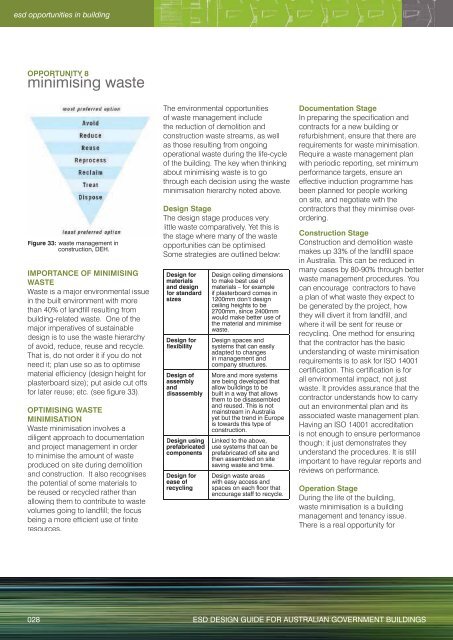
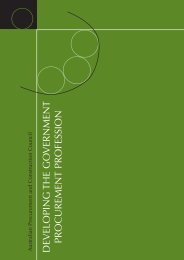
![NATIONAL COST ADJUSTMENT PROVISION EDITION 2 [NCAP2]](https://img.yumpu.com/48266135/1/184x260/national-cost-adjustment-provision-edition-2-ncap2.jpg?quality=85)
